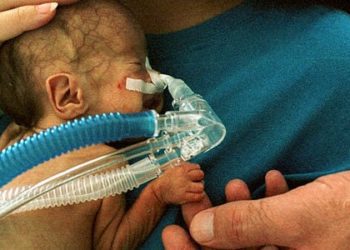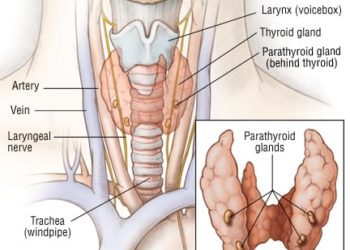Further evidence of link between antithyroid drugs in pregnancy and birth defects
Image: CC/Wiki
1. Both methimazole(MMI)/carbimazole (CMZ) and prophylthiouracil (PTU) were associated with birth defects, with differing presentations.
2. Further studies are needed to establish the specific teratogenic effects of different hyperthyroid therapies in pregnancy.
Evidence rating level: 2 (Good)
Study Rundown: Hyperthyroidism in pregnant women can lead to maternal and fetal complications, such as maternal heart failure, pre-term labor and low birth weight. However, antithyroid drug therapy (ATD) is associated with teratogenic effects, and thus the safety and choice of this therapy in early pregnancy remains unclear. The purpose of this study was to determine the strength of the association between antithyroid therapy with MMI/CMZ and PTU and birth defects.
At the conclusion of the study, the authors found that both therapies were associated with an increased prevalence of birth defects; in particular, MMI/CMZ and PTU with urinary system malformation, PTU with face and neck malformations, and MMI/CMZ with choanal and esophageal atresia and aplasia cutis. However, further studies are needed to establish the role of early switch from MMI/CMZ to PTU therapy in early pregnancy. The authors concluded that newer drug therapies for hyperthyroidism with fewer teratogenic effects are needed.
It should be noted that this study was limited by its retrospective design, in particular missing data on maternal thyroid function tests. However, its findings were strengthened by its large, population-based design, which allowed measurement of this relatively rare outcome.
Click to read the article in JCEM
Relevant reading: Hyperthyroidism in pregnancy
In-Depth [retrospective cohort study]: The study authors used Danish nationwide registers to identify live-borne children born between 1996 and 2008, which ultimately included 849 416 subjects. The authors defined exposed children as those with a mother who had at least 1 redeemed ATD prescription in the time period ranging from 6 months before pregnancy to the end of the 10th gestational week. 1820 children total were defined as exposed. This group was then grouped according to type of ATD treatment: PTU or MMI/CMZ changing to PTU before pregnancy start, MMICMZ exposure or PTU in the beginning of the period changing to MMICMZ before pregnancy start, and MMI/CMZ and PTU exposure after pregnancy start. Nonexposed children were defined as those with mothers with no redeemed ATD prescription or who had only redeemed such prescriptions more than 12 months before or after pregnancy.
At the conclusion of the study, the authors found that birth defects had a prevalence of 8% in PTU, 9.1% in MMI/CMZ, 10.1% in MMI/CMZ and PTU and 5.7% in nonexposed (P < 0.001). Both maternal use of ATD therapy with MMI/CMZ or PTU and maternal shift between these therapies in early pregnancy were associated with increased odds ratio of birth defects. In particular, MMI/CMZ and PTU were associated with urinary system malformation, PTU with malformations in the face and neck region, and choanal and esophageal atresia, omphalocele, omphalomesenteric duct anomalies and aplasia cutis were common in MMI/CMZ exposed children (adjusted OR = 21.8 [13.4-35.4]).
By Monica Parks and Andrew Bishara
More from this author: Rituximab linked with reduced chronic immune disease following stem cell transplantation, High-dose prophylaxis for hemophilia increases costs with minimal benefit, Ambrisentan found ineffective against idiopathic pulmonary fibrosis
© 2013 2minutemedicine.com. All rights reserved. No works may be reproduced without expressed written consent from 2minutemedicine.com. Disclaimer: We present factual information directly from peer reviewed medical journals. No post should be construed as medical advice and is not intended as such by the authors, editors, staff or by 2minutemedicine.com. PLEASE SEE A HEALTHCARE PROVIDER IN YOUR AREA IF YOU SEEK MEDICAL ADVICE OF ANY SORT.







